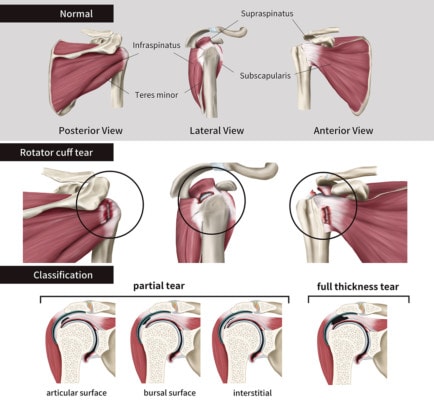Helping a CrossFit Athlete Avoid Rotator Cuff Surgery
I love helping patients avoid rotator cuff surgery. Why? We don’t have good scientific evidence that sewing your torn rotator cuff back together surgically is effective. Why? It may be more about the number of stem cells or lack thereof rather than how well we stitch your tear. A case in point is Bill, a high-level CrossFit athlete whom we helped avoid rotator cuff surgery with a precise injection of his own stem cells.
Rotator Cuff Tear Surgery?

Chu KyungMin/Shutterstock
The rotator cuff is a complex collection of muscles and tendons housed in the shoulder. These muscles support and stabilize the ball-and-socket shoulder joint, allowing you to enjoy a full range of movement when lifting your arm. The rotator cuff can tear, and while this is common in athletes, middle-aged and older people can also tear their rotator cuff. This can happen, for example, while lifting or even catching yourself to prevent a fall. Even more commonly, it can simply happen as we age as part of the normal wear and tear of our bodies. And more often than necessary, surgery seems to be the recommendation, but is rotator cuff tear surgery the way to go?
Why rotator cuff surgery? The theory is that if a patient is in pain and an MRI shows that his or her rotator cuff is torn, sewing it back up will get rid of the pain. On the surface, it seems logical, but the truth is after stitching up a rotator cuff tear, recovery time can be lengthy, many patients never recover their full range of motion, and the pain often continues. Even more concerning is the fact that many studies have shown that the patient’s presurgery shoulder pain may not have anything to do with the rotator cuff tear seen on MRI. Imagine undergoing an invasive surgery to have your rotator cuff stitched up only to discover it isn’t the true source of your pain. If the rotator cuff is injured during exercise or some other traumatic event, it may clearly be the source of the pain; however, surgery still may not be the answer as we have a lot of research showing surgery really may not work any better than no surgery for many types of rotator cuff tears.
Here are a few more reasons you’ll want to think twice before signing on the dotted surgical-consent line for a rotator cuff surgery:
- While it may seem surgery may be the only way to go with larger rotator cuff tears, surgery actually fails with retear occuring in about 6 in 10 patients with large tears.
- Recovery following shoulder surgery is more difficult in those over age 60. In this age group, 1 in 3 rotator cuff tears don’t heal.
- Though there are rare massive tears that may potentially require surgery, most rotator cuff tears (yes, even some of the big ones) can be treated nonsurgically with a precise stem cell injection.
Can a CrossFit Athlete Avoid Rotator Cuff Surgery?
If a new non-surgical technique like ours that uses a precise injection of the patient’s own stem cells could have a durability test, a high level CrossFit athlete would be that test. Why? If you’ve seen the ways these guys work out, you know what I mean. They approach every CrossFit session with incredible passion.
Bill is a high-level CrossFit athlete. Back in August of 2013, he noted anterior shoulder pain and began getting massages, but then he noticed biceps pain all the way down the forearm. His pain increased, and range of motion became a problem, and then all heck broke loose after playing basketball. After that, he was not able to raise his arm above shoulder height without pain, and his CrossFit routines became difficult.
Bill saw Dr. Newton at our Colorado office in July of 2014 and his ultrasound imaging showed a full-thickness rotator cuff tear with some retraction, so in August of 2014, he underwent a same-day stem cell treatment. Dr. Newton precisely placed stem cells into his damaged tendon using ultrasound imaging and using our proprietary protocol.
Bill has been receiving questionnaires through our nonprofit registry and just filled out his two-year questionnaire. He also included the above picture and this note:
“Please let Doc know that the procedure was a wild success. 235# Clean & Jerk, 285# Floor Press, Bar Muscle ups, Overhead Squats. Strength and mobility of the shoulder is actually even better than prior to the tear. Beyond anything I ever expected.”
The upshot? I always get a kick out of helping patients avoid rotator cuff surgery, especially a guy like Bill who, as you can see above, needs to use that shoulder to lift heavy objects! You go, Bill!

NOTE: This blog post provides general information to help the reader better understand regenerative medicine, musculoskeletal health, and related subjects. All content provided in this blog, website, or any linked materials, including text, graphics, images, patient profiles, outcomes, and information, are not intended and should not be considered or used as a substitute for medical advice, diagnosis, or treatment. Please always consult with a professional and certified healthcare provider to discuss if a treatment is right for you.
